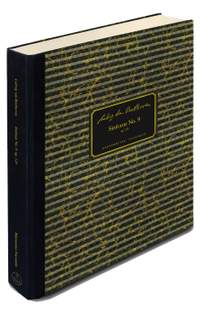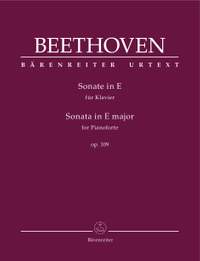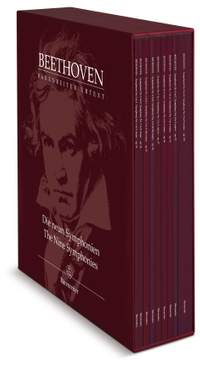Anniversary,
Bärenreiter Beethoven 2020 - Beethoven's Ninth Symphony
 2020 celebrates the 250th birthday of one of the most treasured composers of all time, Ludwig van Beethoven. To celebrate this upcoming birthday Bärenreiter have published a new hardback score and facsimile of arguably Beethoven’s most famous symphony, the Ninth Symphony in D Minor, op. 125. Known for being one of the first examples of a choral symphony, as well as being the final symphony Beethoven composed, the ninth symphony is one of the most performed orchestral symphonies in the world. The fourth movement, which uses the words from Friedrich Schiller’s poem Ode to Joy, is Beethoven’s musical representation of universal brotherhood and contains undoubtedly the most well-known melody the composer ever wrote. In 1972 the main theme of this movement was chosen by the Council of Europe as the European anthem and in 1985 it was adopted by the European Community as its official anthem. Bärenreiter have been tirelessly working to present a number of Beethoven’s works in top-quality editions in time for his anniversary year. All of Beethoven’s symphonies are frequently included in the core repertoire of orchestras worldwide and Bärenreiter offer all nine of them from a single source: the English scholar Jonathan Del Mar. He has edited all nine symphonies and convinced numerous conductors with the results. Ever since Jonathan Del Mar embarked on his edition of the nine symphonies in 1997, Bärenreiter have become, step by step, the premier Beethoven publishing house. By 2020 all the core areas of his œuvre will be available in Urtext editions at the forefront of scholarship.
2020 celebrates the 250th birthday of one of the most treasured composers of all time, Ludwig van Beethoven. To celebrate this upcoming birthday Bärenreiter have published a new hardback score and facsimile of arguably Beethoven’s most famous symphony, the Ninth Symphony in D Minor, op. 125. Known for being one of the first examples of a choral symphony, as well as being the final symphony Beethoven composed, the ninth symphony is one of the most performed orchestral symphonies in the world. The fourth movement, which uses the words from Friedrich Schiller’s poem Ode to Joy, is Beethoven’s musical representation of universal brotherhood and contains undoubtedly the most well-known melody the composer ever wrote. In 1972 the main theme of this movement was chosen by the Council of Europe as the European anthem and in 1985 it was adopted by the European Community as its official anthem. Bärenreiter have been tirelessly working to present a number of Beethoven’s works in top-quality editions in time for his anniversary year. All of Beethoven’s symphonies are frequently included in the core repertoire of orchestras worldwide and Bärenreiter offer all nine of them from a single source: the English scholar Jonathan Del Mar. He has edited all nine symphonies and convinced numerous conductors with the results. Ever since Jonathan Del Mar embarked on his edition of the nine symphonies in 1997, Bärenreiter have become, step by step, the premier Beethoven publishing house. By 2020 all the core areas of his œuvre will be available in Urtext editions at the forefront of scholarship.
Watch the video below to hear about Bärenreiter’s Beethoven editions from Beethoven scholar Jonathan Del Mar, conductor Sir Simon Rattle, and pianist Igor Levit.
Jonathan Del Mar – a Beethoven scholar second to none
 Born in Great Britain, Jonathan Del Mar studied music at Christ Church in Oxford and at the Royal College of Music in London. Since 1985 he has worked extensively on researching the sources for Beethoven’s major works and during this process he has gained invaluable insights into Beethoven’s compositional process. His research has highlighted that previous editions of Beethoven’s symphonies not only contain mistakes, but with regards to the source material as a whole, are incorrect in many details. The basis for past editions had been established in the 19th century, when Complete Editions of prodigious composers including Bach, Mozart, Beethoven and Schubert began. The prompt frequency with which the preceding editions appeared was only possible because the editions were essentially based on a single source which, although it was scrutinised for mistakes and inconsistencies, essentially formed the basis of the edition. The assembly, the assessment and examination of the complete sources for a work and their interconnections according to the methods of classical philology rarely happened.
Born in Great Britain, Jonathan Del Mar studied music at Christ Church in Oxford and at the Royal College of Music in London. Since 1985 he has worked extensively on researching the sources for Beethoven’s major works and during this process he has gained invaluable insights into Beethoven’s compositional process. His research has highlighted that previous editions of Beethoven’s symphonies not only contain mistakes, but with regards to the source material as a whole, are incorrect in many details. The basis for past editions had been established in the 19th century, when Complete Editions of prodigious composers including Bach, Mozart, Beethoven and Schubert began. The prompt frequency with which the preceding editions appeared was only possible because the editions were essentially based on a single source which, although it was scrutinised for mistakes and inconsistencies, essentially formed the basis of the edition. The assembly, the assessment and examination of the complete sources for a work and their interconnections according to the methods of classical philology rarely happened.
In 1996 Del Mar began editing the nine symphonies and completed the scholarly-critical edition within four years. Initially experts were apprehensive but this quickly gave way to enthusiasm. Many world famous composers now use Del Mar's editions of Beethoven’s core repertoire as the basis for their interpretations. Del Mar's exceptional ability to interpret and examine surviving sources helps to preserve Beethoven's musical intentions as closely as possible. In addition to the nine symphonies, other Beethoven works have followed: all of the concertos, the cello sonatas and variations, and string quartets as far as op. 127. The piano sonatas are in the process of being published; nearly half have been published already, and the remainder will be published by 2020.
Bärenreiter New Editions - Beethoven Symphony No. 9 Facsimile and Hard Back Score
Facsimile Edition
 Included in the commentary by Beethoven scholar Lewis Lockwood is a description of the message Beethoven wanted to deliver with this work at the time of composition and how views of this have changed over the centuries. Jonathan Del Mar, comments on noteworthy passages in the autograph manuscript and allows the reader to share in the composer’s working process. Already the large-format paper which Beethoven used for some passages makes the large forces clear. Cuts, sometimes reversed later, show how he wrestled with the final version of the musical text and refined it right down to the last detail. The history of the autograph manuscript reflects an episode in German history: after storage in various places because of the war, the major parts were returned to Berlin but were initially divided by the Berlin Wall and only reunited in 1990. In 2001 the manuscript was listed in UNESCO’s Memory of the World Register. For the first time the facsimile presents all parts of the manuscript including pages preserved in Bonn and Paris as well as the trombone and contrabassoon parts. The first edition (2010) was awarded with the German Music Edition Prize “Best Edition” 2011.
Included in the commentary by Beethoven scholar Lewis Lockwood is a description of the message Beethoven wanted to deliver with this work at the time of composition and how views of this have changed over the centuries. Jonathan Del Mar, comments on noteworthy passages in the autograph manuscript and allows the reader to share in the composer’s working process. Already the large-format paper which Beethoven used for some passages makes the large forces clear. Cuts, sometimes reversed later, show how he wrestled with the final version of the musical text and refined it right down to the last detail. The history of the autograph manuscript reflects an episode in German history: after storage in various places because of the war, the major parts were returned to Berlin but were initially divided by the Berlin Wall and only reunited in 1990. In 2001 the manuscript was listed in UNESCO’s Memory of the World Register. For the first time the facsimile presents all parts of the manuscript including pages preserved in Bonn and Paris as well as the trombone and contrabassoon parts. The first edition (2010) was awarded with the German Music Edition Prize “Best Edition” 2011.
With his ninth symphony, Beethoven ventured into new musical dimensions. In the final movement, soloists and choir join forces with the orchestra and Schiller’s Ode to Joy becomes a global aspiration, a declaration: “Alle Menschen werden Brüder ! / All mankind becomes brothers.”...
Available Format: Sheet Music
Beethoven Symphony No.9 in D minor Op.125 (Full Score, Hardback)
It all started in 1996 with Symphony No. 9: Jonathan Del Mar’s groundbreaking edition of this masterpiece marked the beginning of his new edition of the complete nine symphonies. The editorial process was a huge undertaking because of the complex source situation regarding Beethoven's Symphonies culminating in the Choral Symphony which came in nearly 20 different sources. So it was not surprising that Bärenreiter's new Urtext edition caused a considerable stir in the music world. They became a huge success and have been used by countless orchestras all over the world. In the run-up to the Beethoven Year 2020, Del Mar has returned to the sources 20 years later and scrutinised them afresh. The results: the musical text has withstood the test of time. Bärenreiter's new edition now has an optimised layout and an additional introduction by Barry Cooper. Rounding off this beautiful linen-bound volume are several pages reproduced in facsimile.
Beethoven and Bärenreiter – a marriage made in heaven! In the run up to the Beethoven Year 2020, acclaimed Beethoven scholar Jonathan Del Mar has returned 20 years later and scrutinised his sources afresh... Full scores, study scores and complete performance material to Beethoven’s Ninth Symphony are also available for sale here.
Available Format: Sheet Music
Other New and Bestselling Beethoven Bärenreiter Publications
Beethoven’s final three piano sonatas have always been a source of great fascination. Composed in 1820, the Sonata op. 109 opened the door to the future with its extreme expressivity, its abandonment of traditional techniques and its radical departure from familiar aesthetic norms.
Available Format: Sheet Music
Of the four overtures that Beethoven composed for his only opera, the “Leonore Overture” No. 3 is the most popular. This version of the “Leonore Overture” quickly established itself independently of the stage in the concert hall and has found a lasting place in the symphonic repertoire.
Individual Parts are also available for sale here.
Available Format: Sheet Music
Beethoven described his grandly conceived “Missa solemnis” as “my greatest work” and sold manuscript copies to some of the subscribers even before it had appeared in print. This Urtext edition is designed for everyone seeking a combination of a reliable musical text and well-founded editorial suggestions for a successful performance of this masterpiece...
Individual Parts, Facsimile, Vocal and Choral Scores are also available for sale here.
Available Format: Sheet Music
Ludwig van Beethoven had the ability to create an entire musical universe from the most unassuming and minuscule motif. No classical composer worked more consciously with rhythm than Beethoven: his unmistakable “drive” can be felt in every bar! Here familiar “Beethoven themes” are merged, liberated, shuffled, filtered and recombined with jazz harmonies, standard styles and rhythms. Jean Kleeb’s arrangements sometimes closely follow the original, at other times they comment on or recall Beethoven’s music from afar.
Available Format: Sheet Music
A reference set of Beethoven’s Symphonies for students, conductors and libraries
Available Format: Sheet Music









